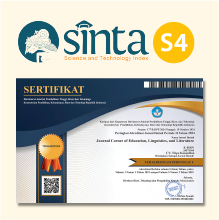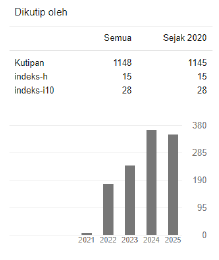An Analysis of Code Switching as a Communication Strategy among the Students in Pandemic Era
 https://doi.org/10.54012/jcell.v2i1.50
https://doi.org/10.54012/jcell.v2i1.50
 Abstract views: 601
Abstract views: 601
 PDF downloads: 278
PDF downloads: 278
Keywords:
Code Switching, Communication Strategy, Descriptive Qualitative, Codes LanguageAbstract
This research is aimed at finding out the types of code switching used by English Language Students at Lampung University as their communication strategy. Moreover, the writer uses descriptive qualitative method by collecting the selected data for the research. In determining the types of code switching, the writer paid attention to the student’s conversation during the presentation. In collecting the data for the research, the writer followed some steps. Firstly, the writer observed the student’s activity in the class room and recording the activity and also the conversation. Secondly, the writer watched again the recorded data which contains of codes language that used by the students. Thirdly, the writer chooses the utterances that consisted of code switching. Forthly, the writer wrote down the data into table. The final step is to analyze the data based on the types and the factors of code switching.Finding reveal that there are two types of code switching used by the students, inter and intra sentential code switching.
Downloads
References
Baker, C. (2000). Foundations of bilingual education and bilingualism. Third Edition. Clevedon: Multilingual Matters.
Chan, B. (2003). Conversational code switching and relevance theory. International Pragmatic Association Journal, 12 (3), 34-8.
Della, Rosa (2016). DISCOURSE MATRIX IN FILIPINO-ENGLISHCODE-SWITCHING: STUDENTS' ATTITUDES AND FEELINGS. i-manager’s Journal on English Language Teaching
Gumperz, J. (Ed.) (1982). Language and social identity. Cambridge: CUP.
Gumperz, J. J. (1982). Discourse strategies. Cambridge: Cambridge University Press. http://dx.doi.org/10.1017/CBO9780511611834
Ibrahim, E. H. E., Shah, M. I. A., & Armia, N. T. (2013). Code-Switching in English
as a Foreign Language Classroom: Teachers' Attitudes. English Language
Teaching, 6(7), 139-150.
Lipski, J. (1985). Linguistic aspects of Spanish-English language switching. Arizona: Center for Latin American Studies.
Kasperczyk, L. (2005). Implementing Code-Switching in the Classroom. Unpublished
undergraduate thesis.
Daemen College, Amherst, New York. Retrieved September 1, 2008, from
http://www.daemen.edu/academics/SRT/articles_files/DURF_Kasperczyk_2005_Paper.pdf
Kaur, S. (2007). Code switching by teachers in the English language classroom. Master practicum report. University Kebangsaan Malaysia.
Reyes, I. (2004). Functions of code-switching in school children’s conversations. Bilingual Research Journal, 28 (1), 77-96.
Skiba, R. 1997. Code switching as a countenance of language interference. The Internet TESL Journal. Retrieved March 3, 2008 from<http://iteslj.org/Articles/SkibaCodeSwitching.html>
Sert, O. 2006. The factors of code switching in ELT classrooms. The Internet TESL Journal. Retrieved March 4, 2008 from http://iteslj.org/Articles/SertCodeSwitching.html
Downloads
Published
How to Cite
Issue
Section
License
Copyright (c) 2022 Asteria eka prasasty

This work is licensed under a Creative Commons Attribution-ShareAlike 4.0 International License.
All articles published in the Journal Corner of Education, Linguistics, and Literature are licensed under the Creative Commons Attribution-ShareAlike License (CC BY-SA).

















